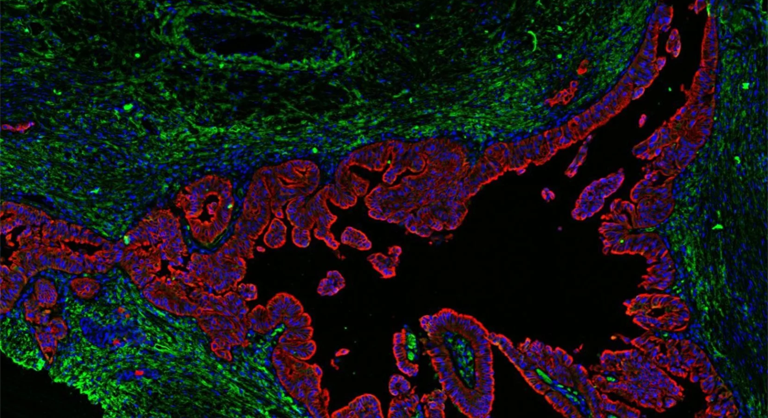Cancer cells frequently overhaul their surroundings, making tumors stiffer than nearby healthy tissue. While tumor stiffening makes some cancers easier to detect — this is why physicians feel for hard lumps in the body — it can also ramp up tumor growth and drug resistance. New research suggests that these detrimental changes are not set in stone, however.
Researchers at Stanford University have created three-dimensional cell cultures, or organoids, using patient cells and a tunable biomaterial to mimic key elements of pancreatic ductal adenocarcinoma (PDAC), a particularly aggressive cancer. In a study in Nature Materials, the authors found that chemoresistance induced by stiff surroundings could be reversed by transferring the cancer cells to a less stiff environment.
The team also identified a specific protein that may tie drug resistance to the stiffening of the scaffolding, or extracellular matrix (ECM), on which cells grow. These mechanisms could become targets in new treatments for PDAC, which is usually diagnosed at a late stage due to a lack of early symptoms and because the tumors are deep inside the body, meaning physicians can’t feel them like they can other cancers.

“By the time people are diagnosed with PDAC, it is often already resistant to chemotherapy. And even if a patient responds well to a drug initially, these tumors can still develop chemoresistance over time, which is very problematic,” said corresponding author Sarah Heilshorn, Ph.D., a professor of materials science and engineering at Stanford.
Past research has suggested that the alterations cancer cells make to the ECM may in turn confer chemoresistance to the cells. The Stanford team, composed of both medical school scientists and engineers, sought to gain a better understanding of the process and how it could be disrupted.
A biomaterial helping hand
To study cancer in a realistic setting in the lab, researchers have created 3D organoids that replicate hallmarks of cancer and offer a high degree of scientific control. However, a drawback of organoids is that their ECM components, which are normally derived from animals, vary greatly from batch to batch and their properties cannot be easily controlled, Heilshorn explained.
For greater consistency in modeling the tumor environment, the researchers used a biomaterial Heilshorn’s lab previously developed called hyaluronic acid and elastin-like protein, or HELP, to create the ECMs used in this study.
Because the researchers can determine the precise number of chemical connections, or crosslinks, between the strands of sugars and proteins that compose HELP, they can precisely control its stiffness.
For this research, the team measured the stiffness of human tumor samples and used the results to guide them in preparing HELP gels.
“We created these designer materials to mimic pertinent mechanical signals that cells sense inside the body,” Heilshorn said. “This allowed us to dive deeper into how PDAC becomes chemoresistant.”
The authors created organoids by adding PDAC cells from human patients to their PDAC-mimicking HELP gels and exposed organoids of varying stiffness to the chemotherapy drug gemcitabine, which is commonly used to treat PDAC.
As expected, cells cultured in the stiffest HELP gels had the most resistance to the treatment. Further analysis showed that these resistant cells presented higher numbers of proteins called drug efflux pumps, which toss chemotherapy drugs out of cancer cells.
Why did stiffer gels result in more pumps? The authors identified a potential missing link in CD44, a protein that is sensitive to ECM stiffness. When the researchers genetically modified human PDAC cells to remove CD44 from organoids completely, they no longer saw differences in chemoresistance between cells grown in low- and high-stiffness gels.
Another key experiment in the study showed that CD44-mediated chemoresistance persisted only as long as cells remained anchored onto stiffer ECM. When the researchers transferred chemoresistant cells from higher to lower stiffness HELP gels, they found that the cells eventually became more vulnerable to gemcitabine.
These results suggest that either disrupting the interaction between CD44 and stiff ECM or reducing the stiffness of the tumor ECM could make PDAC more sensitive to chemotherapy. To find if this is feasible, Heilshorn and her colleagues plan to confirm that the phenomenon they detected in the organoids occurs in animal models of PDAC. They also hope to continue working with the organoids to better replicate the tumor environment and potentially unlock new therapeutic opportunities in the future.
“With a complex disease such as pancreatic cancer, where mechanical forces may be a key player, you need both engineering and clinical expertise to make steps forward. This study exemplifies that,” said David Rampulla, Ph.D., director of the Division of Discovery Science and Technology at the National Institute of Biomedical Imaging and Bioengineering (NIBIB).
This research was supported in part by grants from NIBIB (R01EB027171) and the National Cancer Institute (NCI; R01CA2515143, U01CA217851, U54CA224081, U01CA217851, and DP1CA238296).
This science highlight describes a basic research finding. Basic research increases our understanding of human behavior and biology, which is foundational to advancing new and better ways to prevent, diagnose, and treat disease. Science is an unpredictable and incremental process—each research advance builds on past discoveries, often in unexpected ways. Most clinical advances would not be possible without the knowledge of fundamental basic research.
Study reference: Bauer L LeSavage et al. Engineered matrices reveal stiffness-mediated chemoresistance in patient-derived pancreatic cancer organoids. Nature Materials. DOI: 10.1038/s41563-024-01908-x
